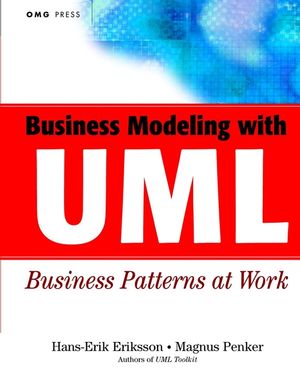Business Modeling with UML: Business Patterns at WorkISBN: 978-0-471-29551-8
Paperback
480 pages
February 2000
 This is a Print-on-Demand title. It will be printed specifically to fill your order. Please allow an additional 10-15 days delivery time. The book is not returnable.
|
||||||
"An excellent hands-on book for practitioners eager to document the
internal structure and everyday workings of business processes.
This clear and practical book belongs on the shelf of everyone
dedicated to mapping, maintaining, and streamlining business
processes." -Richard Mark Soley, Phd, Chairman and CEO, OMG
"Eriksson and Penker have not just written another patterns book; this is a significant contribution to the key field of business-IT alignment. While capturing profound academic insights, what makes the book so refreshing from a practitioner's viewpoint is the richness of accessible, down-to-earth examples and its pragmatic, unpretentious style."-Paul allen Principal of CBD Strategies and Architectures, Sterling Software
"UML may have been designed by and for software engineers, but Eriksson and Penker have defined a practical extension to UML for describing business processes. They put this extended UML immediately to use with a gallery of common business patterns that should jump start any BPR effort."-Philippe Krchten, Director of Process Development Rational Software
"This book is a marriage between proven business modeling concepts and the techniques of UML. It provides real-world strategies for developing large-scale, mission-critical business systems in a manner accessible to both software and business professionals."-ScottW. Ambler, Author of Process Patterns
Following up on their bestselling book, UML Toolkit, Hans-Erik Eriksson and Magnus Penker now provide expert guidance on how to use UML to model your business systems. In this informative book, key business modeling concepts are presented, including how to define Business Rules with UML's Object Constraint Language (OCL) and how to use business models with use cases. The authors then provide 26 valuable Business Patterns along with an e-business case study that utilizes the techniques and patterns discussed in the book.
Visit our Web site at www.wiley.com/compbooks/
"Eriksson and Penker have not just written another patterns book; this is a significant contribution to the key field of business-IT alignment. While capturing profound academic insights, what makes the book so refreshing from a practitioner's viewpoint is the richness of accessible, down-to-earth examples and its pragmatic, unpretentious style."-Paul allen Principal of CBD Strategies and Architectures, Sterling Software
"UML may have been designed by and for software engineers, but Eriksson and Penker have defined a practical extension to UML for describing business processes. They put this extended UML immediately to use with a gallery of common business patterns that should jump start any BPR effort."-Philippe Krchten, Director of Process Development Rational Software
"This book is a marriage between proven business modeling concepts and the techniques of UML. It provides real-world strategies for developing large-scale, mission-critical business systems in a manner accessible to both software and business professionals."-ScottW. Ambler, Author of Process Patterns
Following up on their bestselling book, UML Toolkit, Hans-Erik Eriksson and Magnus Penker now provide expert guidance on how to use UML to model your business systems. In this informative book, key business modeling concepts are presented, including how to define Business Rules with UML's Object Constraint Language (OCL) and how to use business models with use cases. The authors then provide 26 valuable Business Patterns along with an e-business case study that utilizes the techniques and patterns discussed in the book.
Visit our Web site at www.wiley.com/compbooks/



